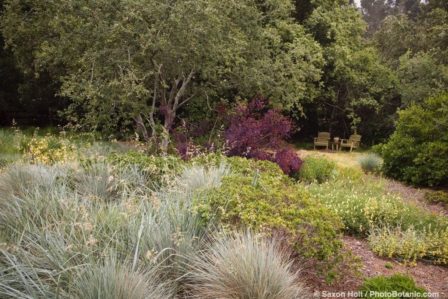40 Years Among the Natives

Live Oak tree (Quercus californica) in California meadow garden with wild rye (Helictotrichon sempervirens), rye (Leymus condensatus) David Fross
In April I went to the San Diego Horticultural Society at the Del Mar racetrack to hear David Fross talk about plants native to California. He arrived at his current career by a circuitous route. Fross had been drawn to natural landscapes as a child. However, he majored in history; and as a graduate student on a field trip in a geography class, he “met a friend” he hadn’t “seen for a long time.” Fross stayed with the plant, a wild carex, for 20 minutes or so getting reacquainted. This led to moving to San Luis Obispo where he earned a graduate degree in agriculture. There one of his professors introduced him to his 96 year-old grandmother, a California native-plant expert and famous horticulturist. Fross was fascinated by her as she was advocate of using native plants in California long before it became popular. Drought also made him aware of the benefits of planting natives. In 1978 he opened, using his wife’s money, a wholesale nursery specializing in natives. He called it Native Sons. As time went on he expanded his inventory to include plants that are suited for Mediterranean-style climates. His goal is to provide plants for those who are interested in responsible gardening while having fun.
Responsible gardening does not guarantee success. Experimentation is important. This means accepting plant deaths as part of the learning curve. In means knowing your soil, the micro climates on your property, and being willing to move plants to another location if they fail to thrive in their original location. In fact, his home landscape began as a garden needing full sun, but over time plants grew shading the area and forcing him to re-think his design. When you plant, you must consider scale, color, texture and the plant’s physical needs. As the garden matures, you may need to make changes.
The plants Fross grows include California natives as well as those from Mediterranean climates including Australia, South Africa, Chile and the land surrounding the Mediterranean. In other words, he grows plants that thrive in a climate of warm, dry summers and moderate winter rainfall.
He cautions that established plants may be drought tolerant, but they do need some moisture. A drought tolerant plant can survive for a time by losing its leaves or going dormant. If normal conditions do not return in time, the plant will definitely die. In other words, drought tolerant plants need regular watering. They will need more if it is extremely hot or windy, you will need to water at least once or even twice a week. Plants that do not require a great deal of water should be given water every 10 to 14 days. Occasional watering is waiting three to four weeks between watering. Infrequent water consists of deep water every four to six weeks in summer. Potted plants need more frequent watering.
California natives are not necessarily drought resistant. Many grow in marshes and could not survive in a drought tolerant garden setting. A drought resistant plant (Xeric) thrives in drought conditions. All young plants need water until they are established. Fross supplies plants to over 100 retail nurseries, but he will not sell any plant that cannot flourish under his benign neglect.
In addition to help conserve water, native and Mediterranean drought tolerant and resistant plants need very little pruning, do not need fertilizer, and most need no pesticides. They also attract birds and other pollinators. Best of all, these plants can give you many different effects. For example, Escallonia, Japanese Privet, and Oleander survive with little or no care. If you want the look of a meadow, we have many grasses and sedges that work. A low growing manzanita makes a nice cover for a bank. For privacy there are many choices.
Lemonadeberry was planted in Santa Barbara’s Botanic Garden in the 1940s. To maintain its shape and size, it is pruned three to four times a year. Wax myrtle, California bay, Toyon, Catalina Cherry, and California lilac make good privacy barriers which may be pruned occasionally or sheared regularly, depending on what you want.
Fross gave a very interesting talk and showed us how beautiful a water-thrifty garden can be. I am certain we all learned about many new possibilities. At any rate, he has added to my gradual acceptance of these plants’ presence in my landscape.
Come to the June meeting and learn about Breadfruit, the Food of the Future. The meeting will be between 6 and 8 p.m. at 4070 Jackdaw (between West Lewis and Fort Stockton). Members are free; guests pay $10, which can be applied to your membership if you join that day.
Category: Life Style, Local News







